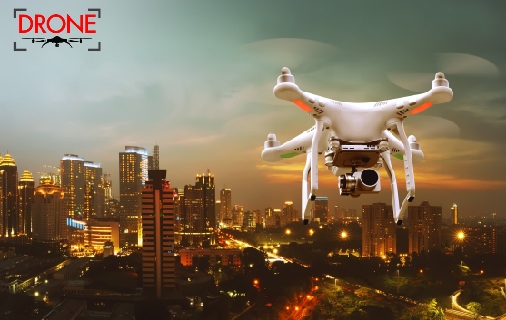Article by Suwan Juntiwasarakij, PhD, Senior Editor
นอกจากจะเป็นงานอดิเรกที่ได้รับความนิยมอย่างท่วมท้นแล้ว ไม่นานมานี้อากาศยานไร้คนขับขี่ “โดรน” ยังกลายมาเป็นเทคโนโลยีชิ้นสำคัญขององค์กรอันมีรูปแบบการใช้งานเป็นตัวขับเคลื่อนประโยชน์และคุณค่าของเทคโนโลยีดังกล่าว โดยมีซอฟต์แวร์เป็นตัวขับความสามารถทางด้านการนำทางอัตโนมัติและวิเคราะห์ข้อมูลที่ โดรน ตรวจจับได้ประเมินคุณค่าการใช้งานในทางปฏิบัติ เช่น งานสำรวจพื้นที่ก่อสร้าง งานพืชผลทางการเกษตร งานตรวจคลังสินค้า งานการจราจร งานเฝ้าระวังเหตุการณ์ชุมนุม งานตอบสนองต่อวิกฤตภัย งานค้นหาและกู้ภัย งานลาดตระเวนเพื่อความปลอดภัย และงานอื่นที่ประยุกต์ใช้ความสามารถคุณสมบัติของโดรน ได้เวลาแล้วที่องค์กรจะต้องก้าวข้ามการใช้งาน โดรน จากการอำนวยความสะดวกไปสู่การบูรณาการข้อมูลที่ตรวจจับด้วยโดรนเข้าระบบสาระสนเทศเพื่อยกเครื่องและขับเคลื่อนระบบงานให้เกิดประสิทธิภาพสูงสุดเท่าที่ขีดความสามารถของ โดรน
The Application Landscape
มีการคาดการณ์ว่ามูลค่าตลาดของ โดรน ในระดับนานาชาติจะทะยานขึ้นจากเดิม 2 พันล้านเหรียญในปัจจุบัน สู่ 127 ล้านเหรียญภายในปี 2020 บทวิเคราะห์ของ PwC กล่าวไว้ว่า อุตสาหกรรมหลักที่ส่งผลต่อการเติบโตของอุตสาหกรรมภาคการให้บริการโดรน ได้แก่ อุตสาหกรรมโครงสร้างพื้นฐาน อุตสาหกรรมการเกษตร และอุตสาหกรรมการขนส่ง ในการสำรวจโครงสร้างพื้นฐานนั้น โดรนจะสามารถช่วยหรือแม้กระทั่งทดแทนแรงงานมนุษย์ในการตรวจตราโครงสร้างที่มีความเสี่ยง เช่น การพังทลายของวัสดุ ตัวโครงสร้าง ระบบวางท่อ หรือแม้แต่การรั่วซึม

Source: PwC, POSTgraphics
โดรนยังนำไปใช้เพื่อบริการขนส่ง ณ ปลายทางของการลำเลียงสินค้า ซึ่งจะมาแทนที่บริการไปรษณีย์ในพื้นที่ยากเข้าถึง รวมทั้งการลำเลียงส่งสินค้าทางทะเลขณะที่เรือพาหนะกำลังเทียบท่าหรือกำลังออกจากท่า รวมทั้งการขนส่งทางอากาศหรือทางบกที่พาหนะที่มีมนุษย์ขับขี่ไม่สามารถเข้าถึง โดรนในงานเกษตรกรรมจะใช้ในงานรวบรวมเพื่อวิเคราะห์ข้อมูลผลผลิตได้อย่างรวดเร็ว และยังพ่นฉีดสารต่อต้านแมลงเพื่อดูแลรักษาพืชผลได้อย่างแม่นยำ หรือแม้กระทั่งใช้โดรนขนาดจิ๋วเพื่อผสมเกสรในบริเวณที่ประชากรผึ้งมีจำนวนจำกัด ขีดความสามารถดังกล่าวนี้ ผู้ประกอบการ เจ้าของไร่สวนพืชผักผลไม้ จึงสามารถค้นพบ ระบุปัญหา และสร้างแผนการดูแลรักษาฟื้นฟูแบบเฉพาะเจาะจงได้แบบทันท่วงที
Alternatives to Traditional Transits
เฮนรี่ย์ ฟอร์ดเคยกล่าวไว้ “มั่นใจได้เลย การผสมรวมตัวกันของเครื่องบินและรถยนต์กำลังจะเป็นจริง อาจฟังดูน่าขำ แต่เชื่อว่ามาแน่นอน” ทุกวันนี้โดรนได้รับความนิยมขึ้นเรื่อยๆ กฎระเบียบต่างๆที่ออกมาล้วนแต่สนับสนุนการใช้โดรนเชิงพาณิชย์ การออกแบบพัฒนาก็รุดหน้าอย่างรวดเร็ว ขณะนี้ผู้ลิตโดรนเพื่อการโดยสารได้ดำเนินการสู่ขั้นตอนการสร้างคอนเซปต์และการออกแบบเป็นที่เรียบร้อยแล้ว ผู้ผลิตรายสำคัญๆ กำลังอยู่ในขั้นการสร้างเครื่องต้นแบบและทดสอบ ทั้งนี้คาดว่าพร้อมส่งลงตลาดภายในปี 2020 ในแง่ของเทคโนโลยีแล้ว ผู้ผลิตต่างมีเทคโนโลยีขั้นสูงอยู่ในมือ รอเวลาเมื่อกฎระเบียบต่างๆ ได้ลงตัวแล้ว คงจะได้เห็นโดรนเพื่อการโดยสารได้สยายปีกบินในปี 2020

Source: DRONEII.com
Security and Military Defense
นอกจากโดรนได้พิสูจน์ความคุ้มค่าในภาคธุรกิจเอกชนที่สะท้อนต้นทุนที่ต่ำลงแล้ว ความสามารถในการรับส่งข้อมูลแบบเวลาจริงยังสามารถนำไปสร้างคุณประโยชน์ทางการทหารและขนส่งได้อีกด้วย ผลการวิเคราะห์ของ BI Intelligence ได้กล่าวว่าตลาดโดรนในระดับนานาชาติจะมีมูลค่ากว่า 12 พันล้านเหรียญในปี 2024 ซึ่งตลาดภาคการกำลังทหารจะยังมีส่วนใหญ่ที่ใหญ่กว่าภาคพลเรือนหลายเท่า ภาคการกำลังทหารจะยังนำการเติบโตของตลาดและการใช้จ่ายต่อไปทั้งนี้เพราะมีงบประมาณใช้จ่ายที่สูงขึ้นมีผลมาจากนโยบายการป้องกันประเทศที่ให้น้ำหนักการลงทุนกับเทคโนโลยีโดรนที่มากขึ้น

Source: Deloitte
The Killer Apps, However
อย่างไรก็ตามโดรนจะแสดงขีดความสามารถสูงสุดก็ได้เมื่อได้ใช้ควบคู่ไปกับซอฟต์แวร์ที่เหมาะสม ซอฟต์แวร์ที่ออกแบบมาอย่างชาญฉลาดจะสามารถนำศักยภาพที่แท้จริงของโดรนออกมาเพื่อใช้ประโยชน์ ตัวอย่าง Walmart ได้ใช้โดรนเข้ากับเทคโนโลยีประมวลภาพ ช่วยในสำรวจตรวจเช็คคลังสินค้า ด้วยระบบซอฟต์แวร์ที่สามารถตรวจจับสินค้าในคลังที่มีปริมาณหรือจำนวนน้อยกว่าค่าที่ตั้งไว้หรือตรวจสอบกรณีสินค้าพลัดถิ่น ในขณะที่ซุปเปอร์มาร์เก็ตทั่วไปตรวจมีรอบเวลาการตรวจเช็คสินค้าคงคลังอยู่ที่ 30 วัน แต่ Walmart สามารถทำได้ภายใน 1 วัน โดรนยังใช้เพื่อการตรวจสอบแนวโน้มพฤติกรรมของผู้บริโภคโดยใช้ซอฟต์แวร์ที่มีความสามารถทางด้านประมวลภาพและเทคโนโลยีปัญญาประดิษฐ์ deep learning เพื่อนับจำนวนลูกค้า หรือค้นหาเพื่อระบุผู้ที่ไม่ได้รับอนุญาตในพื้นที่หวงห้ามในงานก่อสร้าง
Caution Attached
ถึงแม้ว่าคุณประโยชน์การใช้สอยที่มีอยู่เป็นจำนวนมาก็ตาม โดรนก็ไม่ต่างจากเทคโนโลยีอื่นซึ่งมีเจตนารมณ์ของผู้ใช้เป็นสำคัญ บทวิเคราะห์ของ Raconteur กล่าวว่า มีความวิตกกังวลว่าโดรนอาจจะเป็นเครื่องใช้ประกอบอาชญากรรม เช่น ใช้ลักลอบขนส่งสารต้องห้ามเข้าสู่เรือนจำ ใช้ติดตามความเคลื่อนไหวของเจ้าหน้าที่ตำรวจ หรืออาจนำไปประกอบการก่อการร้าย ด้วยเหตุนี้รัฐบาลแคนาดาและจีนได้ออกข้อบังคับที่เข้มงวดเพื่อควบคุมการใช้โดรนในพื้นที่เช่นบริเวณสนามบิน จีนผู้ผลิตโดรนรายใหญ่ที่สุดของโลกได้ดำเนินการไปอีกขั้นโดยออกกฎให้ลงทะเบียนโดรนเพื่อใช้ในการติดตามเจ้าของ ที่เป็นตัวอย่างเมื่อไม่นานมานี้ คือเจ้าหน้าตำรวจหูหนานตอนกลางของจีนได้ยิงปืนปล่อยประจุรบกวนคลื่นวิทยุที่ใช้บังคับโดรนขนส่งสินค้า เป็นผลให้โดรนร่วงหล่นจากท้องฟ้า

Source: TealGroup, BI Intelligence

Source: Deloitte Analytics












